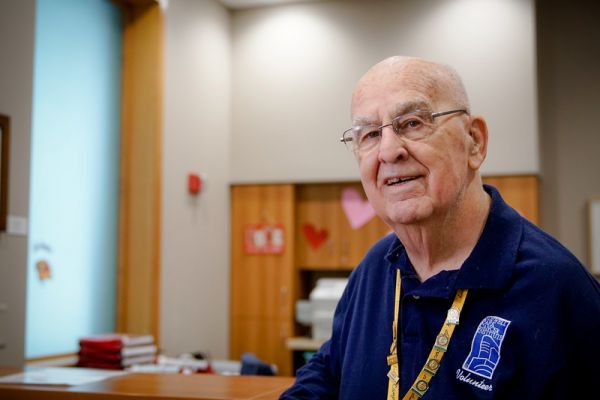Roswell Park’s expertise in pain intervention techniques offers long-lasting relief and reduces use of opioids
If you have cancer-related spinal pain or fractures and you could have a minimally invasive, outpatient surgery that offers relief — often within hours — and allows you to avoid or decrease the use of opioids, would you do it? For Roswell Park patient Carol Kyle, the answer was a definite yes.
In January 2018, Carol was one of the first patients in Western New York to benefit from the combination of two groundbreaking pain intervention techniques in a single session – vertebral augmentation and vertebral radiofrequency ablation (RFA) – offered by two of the region’s most experienced practitioners of the procedures at Roswell Park.
Both of these outpatient procedures are safe, fast and offer the potential for prolonged relief of cancer-related pain that affects the spine, nerve roots and the sacrum, without the use of prolonged opioid therapy.
What Causes Spinal Pain in Cancer Patients?
Vertebral pain and fractures are common in cancer patients for a variety of reasons, according to Roswell Park’s Ronald Alberico, MD, Director, Neuroradiology/Head & Neck, Department of Diagnostic Radiology. Metastases to the bone, especially the spine, hips and pelvis, are common in patients with metastatic cancers of the breast, prostate, liver and lung. Some treatments and side effects can result in a loss of bone density, making patients susceptible to painful vertebral compression and fractures. Exposure to steroids (often used during treatment to reduce inflammation and immune response or improve appetite) and malnutrition or inactivity all affect bone density.
Vertebral Augmentation
To help relieve pain and stabilize spinal fractures, Roswell Park first began offering patients a technique known as vertebral augmentation, specifically kyphoplasty, in 2001.
We were the first clinic in Western New York to offer vertebral augmentation for cancer patients, and our experience makes a difference.Ronald Alberico, MD
“With vertebral augmentation, a liquid bone cement is injected into any cracks or breaks in the vertebrae, supporting the bone and preventing it from fracturing more. In the case of a compression fracture, a balloon can be inserted into the bone to help elevate the vertebra back to its normal rectangular shape. All this is done through needles, under conscious sedation and local anesthesia, and once the procedure is done, we put a small bandage over the needle insertion point and the patient can usually go home a few hours later.”
With over 5,000 vertebral augmentation procedures performed over the past 18 years, Dr. Alberico reports 90% of patients stated their pain was eliminated or significantly reduced, sometimes within hours. The pain relief was long lasting, frequently allowing patients to decrease their use of opioid pain medicines.
Dr. Alberico also notes that patients are referred to Roswell Park for this procedure not only by Roswell Park physicians, but also by outside sources. “Patients can bring any imaging they’ve already had done, and/or we can image and examine them, to see if pain they’re having is related to a vertebral fracture.”
Vertebral Radiofrequency Ablation
In 2017, Dr. Alberico and his Roswell Park colleague, diagnostic radiologist Ahmed Belal, MD, became the first local practitioners to use a new spinal pain relief procedure known as vertebral radiofrequency ablation (V-RFA).
While Roswell Park has been using RFA techniques for years to kill tumors in soft tissue, V-RFA is specifically used to relieve pain and treat tumors in the spine. “Vertebral RFA uses a probe to deliver an electrical current produced by a radio wave and heats up a small area of tissue, thereby decreasing pain signals from that specific area,” Dr. Alberico explains. Pain is relieved by the heating of sensory nerves in and around the treated area of tissue. “Dr. Belal and I were trained at the first class for the use of the Osteocool® spinal RFA device, and we have more experience with this procedure than any other practitioner in Western New York.”
Never miss another Cancer Talk blog!
Sign up to receive our monthly Cancer Talk e-newsletter.
Sign up!Other new techniques to relieve bone-related pain in cancer patients and reduce or eliminate opiates are encouraging. “Indications for bone RFA have expanded to include other locations, such as the femur and other long bones. We have also had success with cryoablation, which uses a probe to apply extreme cold to freeze or numb nerves between the ribs, for patients with painful pathologic rib fractures and infiltrative tumor around these areas. This technique can be used to relieve pain from joints in the lower back. We also offer facet and nerve root blocks as well as epidural steroid injections for lumbar pain.”
A Patient’s Experience with RFA and Vertebral Augmentation
Which brings us back to Roswell Park patient Carol Kyle. While she was being treated for breast cancer, a CT scan revealed an area where the cancer had spread to Carol’s spine, along with a fracture. “I had a lot of pain in my back, and my Roswell Park doctor referred me to Dr. Alberico,” Carol recalls. In January 2018, Carol received both vertebral RFA and vertebral augmentation for spinal pain in a single session. “For the surgery, I had some local anesthesia, and just one little incision, which was covered with a small Band-Aid. A few hours later, I was ready to go home. The surgery helped relieve my back pain almost immediately, and I did not need to take any painkillers. I have not had any pain in my back for over a year, and I couldn’t be more grateful.”
Editor’s Note: Cancer patient outcomes and experiences may vary, even for those with the same type of cancer. An individual patient’s story should not be used as a prediction of how another patient will respond to treatment. Roswell Park is transparent about the survival rates of our patients as compared to national standards, and provides this information, when available, within the cancer type sections of this website.





